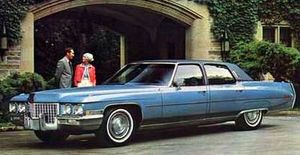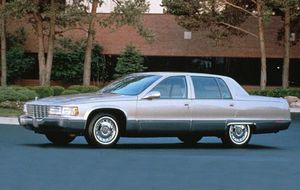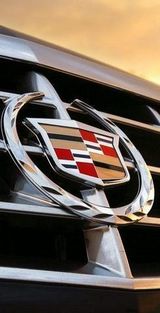.
Cadillac Fleetwood Brougham

| |
| Cadillac Fleetwood Brougham | |
|---|---|
| Cadillac | |
| aka | {{{aka (Type here, not up there)}}} |
| Production | 1947–1996 |
| Class | Full-size luxury car |
| Body Style | 2-door coupe 2-door convertible 4-door sedan 4-door limousine |
| Length | {{{length - type here}}} |
| Width | {{{Width - type here}}} |
| Height | {{{Height - type here}}} |
| Wheelbase | {{{wheelbase - type here}}} |
| Weight | {{{Weight - you get the point}}} |
| Transmission | {{{transmission + drive}}} |
| Engine | {{{engine}}} |
| Power | {{{Horsepower and Torque rating}}} |
| Similar | {{{similar (competition)}}} |
| Designer | {{{Designer (lead designer if it was a team effort)}}} |
The Cadillac Fleetwood Brougham was a large automobile produced from 1947 through 1996. The name combined two famous Cadillac trim lines, Fleetwood and Brougham, and was intended to signify the finest that the maker could produce.
See Wikicars' comprehensive <MODEL> Review.
Recent Changes
Mention any minor facelifts or major changes made to the vehicle here.
Styles and Major Options
Certain vehicles come in different trim levels or body styles. Features and major options should be mentioned here.
Pricing
Add more fields as necessary.
|
MODEL Trims |
|||
|
Trim1 |
Trim2 |
Trim3 |
Trim4 |
|
MSRP |
|||
|
$Price1 |
$Price2 |
$Price3 |
$Price4 |
|
Invoice |
|||
|
$Price1 |
$Price2 |
$Price3 |
$Price4 |
Gas Mileage
Add more fields as necessary.
As seen on the FuelEconomy.gov website, the City/Highway MPG averages are as follows:
|
Trim |
|||
|
Trim1 |
Trim2 |
Trim3 |
Trim4 |
|
MPG |
|||
|
c/h |
c/h |
c/h |
c/h |
Reliability
Warranty options and scheduled maintainence information should be mentioned here.
Safety
This section should reference points on safety ratings and features of the vehicle.
Photos
Add Photos of the vehicle here.
Please make sure not to use copyrighted photos.
Colors
List the colors that the particular <MODEL> is offered in.
Main Competitors
Create links to other <MAKE> <MODEL> pages in this section.
Hybrid Models
If there are hybrid versions of this vehicle manufactured, then please elaborate a little bit on it here.
Unique Attributes
If there are any features of this vehicle that sets it apart from other vehicles in its class, then mention those unique attributes here.
Resale Values
Add more fields as necessary.
|
<MODEL> Year |
|||
|
Year X |
Year X-2 |
Year X-3 |
Year X-4 |
|
Resale Value |
|||
|
$ |
$ |
$ |
$ |
Criticisms
Please make sure to keep critiques in a third-person point of view. If using criticisms from a reputable automotive source, then please make sure to cite the quote.
Generations
Fill in as many as appropriate. Add more if necessary and pictures wherever applicable.
Please make sure NOT to use copyrighted pictures.
Final Generation: (1993–1996)

| |
| Cadillac Fleetwood Brougham | |
|---|---|
| Cadillac | |
| aka | Thirteenth generation |
| Production | 1993–1996 |
| Class | {{{Class}}} |
| Body Style | 4-door sedan 4-door limousine |
| Length | {{{length - type here}}} |
| Width | {{{Width - type here}}} |
| Height | {{{Height - type here}}} |
| Wheelbase | {{{wheelbase - type here}}} |
| Weight | {{{Weight - you get the point}}} |
| Transmission | {{{transmission + drive}}} |
| Engine | {{{engine}}} |
| Power | {{{Horsepower and Torque rating}}} |
| Similar | {{{similar (competition)}}} |
| Designer | {{{Designer (lead designer if it was a team effort)}}} |
For 1993, the Fleetwood Brougham was redesigned and moved to the D-body platform to replace the Brougham. The wheelbase grew to 113.8 inches.
The Fleetwood Brougham was available with the new 260 hp, 330 lb./ft. (201 kW) LT1 Chevrolet 350 V8, derived from the Chevrolet Corvette and shared with the Chevrolet Impala SS, Chevrolet Caprice 9C1, and Buick Roadmaster.
The Cadillac Fleetwood, along with its B-Body stablemates, was retired by General Motors in December of 1996.
Tenth and Eleventh generation (1985–1991)
| {{{Image}}} | |
| Cadillac Fleetwood Brougham | |
|---|---|
| Cadillac | |
| aka | Tenth generation |
| Production | 1985–1988 |
| Class | {{{Class}}} |
| Body Style | 2-door coupe 2-door convertible 4-door sedan 4-door limousine |
| Length | {{{length - type here}}} |
| Width | {{{Width - type here}}} |
| Height | {{{Height - type here}}} |
| Wheelbase | {{{wheelbase - type here}}} |
| Weight | {{{Weight - you get the point}}} |
| Transmission | {{{transmission + drive}}} |
| Engine | {{{engine}}} |
| Power | {{{Horsepower and Torque rating}}} |
| Similar | {{{similar (competition)}}} |
| Designer | {{{Designer (lead designer if it was a team effort)}}} |
In 1985, the second generation of down-sized Devilles and Fleetwoods (other than the Brougham) would see a switch to front wheel drive. This drastic downsizing did not prove popular with consumers and soon Lincoln was outselling Cadillac. The Fleetwood Brougham had merely become a mid-size model, and continued to compete with other mid-size luxury sedans such as the BMW 5-Series, Lincoln Continental, Mercedes-Benz 500E, Volvo 700, Acura Legend and Audi 100.
From 1986 through 1992, Fleetwood Brougham was an option package on the Deville.
| {{{Image}}} | |
| Cadillac Fleetwood Brougham | |
|---|---|
| {{{Marque}}} | |
| aka | Eleventh generation |
| Production | 1989–1992 |
| Class | {{{Class}}} |
| Body Style | 2-door coupe 2-door convertible 4-door sedan 4-door limousine |
| Length | {{{length - type here}}} |
| Width | {{{Width - type here}}} |
| Height | {{{Height - type here}}} |
| Wheelbase | {{{wheelbase - type here}}} |
| Weight | {{{Weight - you get the point}}} |
| Transmission | {{{transmission + drive}}} |
| Engine | {{{engine}}} |
| Power | {{{Horsepower and Torque rating}}} |
| Similar | {{{similar (competition)}}} |
| Designer | {{{Designer (lead designer if it was a team effort)}}} |
Ninth generation (1977–1984)
Template:Infobox Automobile generation In 1977, the first generation of down-sized Cadillacs included mechanically similar Devilles and Fleetwoods, with the latter still occupying the top of the lineup. The models were almost identical from 1977 through 1984.
When General Motors initiated the redesign of the B-body and C-body for the 1977 model year the De Ville (and all other full-size GMs) shrank by 9.8 in (249 mm) and about 750 lb (340 kg). The new standard engine was a 425 in³ (6.9 L) V8.
Fifth, Sixth, Seventh and Eighth generation (1965–1976)
| {{{Image}}} | |
| Cadillac Fleetwood Brougham | |
|---|---|
| Cadillac | |
| aka | Fifth generation |
| Production | 1965–1968 |
| Class | {{{Class}}} |
| Body Style | 2-door coupe 2-door convertible 4-door sedan 4-door limousine |
| Length | {{{length - type here}}} |
| Width | {{{Width - type here}}} |
| Height | {{{Height - type here}}} |
| Wheelbase | {{{wheelbase - type here}}} |
| Weight | {{{Weight - you get the point}}} |
| Transmission | {{{transmission + drive}}} |
| Engine | {{{engine}}} |
| Power | {{{Horsepower and Torque rating}}} |
| Similar | {{{similar (competition)}}} |
| Designer | {{{Designer (lead designer if it was a team effort)}}} |
Beginning in 1965, Fleetwood Brougham denoted Cadillac's flagship model, above the Calais and the DeVille.
Performance was sprightly, with 0-60 mph (0-96 km/h) in less than nine seconds, although the standard drum brakes were inadequate (disc brakes were optional in 1965 and standard starting in 1966). Sales were excellent despite high list prices.
For 1968 the Fleetwood Brougham gained slight exterior changes to comply with new federal safety and emissions legislation, and as with the rest of the Cadillac lineup, a new 472 in³ (7.7 L) V8 engine rated at 375 hp (sae gross). In 1969 it lost its hidden headlamps and picked up as options a halo vinyl roof and later in the model year a power sunroof option. For the 1970 model year, this body style Fleetwood Brougham introduced the new 500 in³ 8.2 L V8 engine (rated sae gross 400 hp/550 ft·lbf in 1970) that would be an Fleetwood Brougham exclusive until it became standard on all full size Cadillacs for model years 1970 through 1976.
For 1965, the Eldorado and Sixty Special officially became part of the Fleetwood line along with the Seventy-Five. In 1966, Fleetwood Brougham became a separate model line.
The Fleetwood Brougham, like other Cadillacs, grew substantially larger and more powerful from 1949 through the early 1970's. By 1973 it was 4 in. (101.6 mm) longer in wheelbase, 17 inches (431.8 mm) longer overall, and more than 900 lb (408 kg) heavier, and its standard V8 engine had grown from 331 in³ (5.4 L) to 472 in³ (7.7 L).
The Fleetwood Brougham remained a 'B' pillared hardtop with frameless doors from 1965 through the 1976 model year. 1965 thru 1967 models had window vents on all 4 doors. this means a total of 8 side windows. 1968 dropped these vents on the front doors. 1969 dropped them on back doors.
| {{{Image}}} | |
| Cadillac Fleetwood Brougham | |
|---|---|
| Cadillac | |
| aka | Sixth generation |
| Production | 1969–1970 |
| Class | {{{Class}}} |
| Body Style | 2-door coupe 2-door convertible 4-door sedan 4-door limousine |
| Length | {{{length - type here}}} |
| Width | {{{Width - type here}}} |
| Height | {{{Height - type here}}} |
| Wheelbase | {{{wheelbase - type here}}} |
| Weight | {{{Weight - you get the point}}} |
| Transmission | {{{transmission + drive}}} |
| Engine | {{{engine}}} |
| Power | {{{Horsepower and Torque rating}}} |
| Similar | {{{similar (competition)}}} |
| Designer | {{{Designer (lead designer if it was a team effort)}}} |

| |
| Cadillac Fleetwood Brougham | |
|---|---|
| Cadillac | |
| aka | Seventh generation |
| Production | 1971–1973 |
| Class | {{{Class}}} |
| Body Style | 2-door coupe 2-door convertible 4-door sedan 4-door limousine |
| Length | {{{length - type here}}} |
| Width | {{{Width - type here}}} |
| Height | {{{Height - type here}}} |
| Wheelbase | {{{wheelbase - type here}}} |
| Weight | {{{Weight - you get the point}}} |
| Transmission | {{{transmission + drive}}} |
| Engine | {{{engine}}} |
| Power | {{{Horsepower and Torque rating}}} |
| Similar | {{{similar (competition)}}} |
| Designer | {{{Designer (lead designer if it was a team effort)}}} |
| {{{Image}}} | |
| Cadillac Fleetwood Brougham | |
|---|---|
| Cadillac | |
| aka | Eighth generation |
| Production | 1974–1976 |
| Class | {{{Class}}} |
| Body Style | 2-door coupe 2-door convertible 4-door sedan 4-door limousine |
| Length | {{{length - type here}}} |
| Width | {{{Width - type here}}} |
| Height | {{{Height - type here}}} |
| Wheelbase | {{{wheelbase - type here}}} |
| Weight | {{{Weight - you get the point}}} |
| Transmission | {{{transmission + drive}}} |
| Engine | {{{engine}}} |
| Power | {{{Horsepower and Torque rating}}} |
| Similar | {{{similar (competition)}}} |
| Designer | {{{Designer (lead designer if it was a team effort)}}} |
Third and Fourth generation (1955–1964)
Template:Infobox Automobile generation Template:Infobox Automobile generation For 1955, the Fleetwood Broughams body gained its own rear end styling with high, slender, pointed tailfins. These contrasted with the rather thick, bulbous fins which were common at the time and were an example of Fleetwood Brougham once again pointing the way forward.
In 1956 the Fleetwood Brougham was joined by the Sedan de Ville, a four-door hardtop sedan and the Coupe de Ville a two-door hardtop coupe and a two-door convertible coupe. The Sedan de Ville would ultimately outlive its two-door predecessor. For 1956, a two-door hardtop coupé version appeared, called the Eldorado Seville.
1957 saw the base Fleetwood Brougham and Seville coupe once again present an innovative rear-end design, a low, downswept fenderline capped by a pointed, in-board fin. The rear fenders were commonly referred to as "chipmunk cheeks". This concept was used for two years, but did not spawn any imitators.
1957 was chiefly notable, though, for the introduction of one of GM's most memorable designs, the Eldorado Brougham. This four-door hardtop with rear-opening rear doors was an ultra-luxury car that cost an astonishing $13,000+, more than the Rolls-Royce Silver Cloud of the same year. It featured a stainless steel roof, air suspension, the first dual headlights, the first memory power seats, and every possible kind of appearance and convenience feature that GM's most inventive minds could devise. This design ran for two years and of course sold in very small quantities (704 units in total) owing to the price. It has been estimated that GM lost $10,000 on every one, but these virtually hand-assembled cars are today among the rarest and most collectible of all postwar American models.
A different Eldorado Brougham was sold for 1959 and 1960. These cars were not quite so extravagantly styled but were very unusual pieces in themselves. Priced at $13,075, they cost $1 more, each, than their older siblings. The design was 100% Cadillac but the company contracted out the assembly to Pininfarina of Italy, with whom the division has had a long-running relationship, and these Eldorado Broughams were essentially hand-built in Italy. Their discreet, narrow taillights, nicely integrated into modest tailfins, contrasted sharply with the "rocketship" taillights and massive fins of the standard 1959 Cadillacs and were an indication of where Caddy styling would go in the next few years. However, build quality was not nearly to the standard of the Detroit hand-built 1957–1958's, and the 1959–1960 Broughams are less desirable, it seems, than the 1st generation Broughams, although their value and collectibility remain high.
In 1959 the Fleetwood line was separated in a distinct Series 63.
First and Second Generations/Origins (1947-1954)
Template:Infobox Automobile generation Template:Infobox Automobile generation The first Cadillac to bear the name was the 1947 Fleetwood Brougham, with a sedan version and with a coupe version and with a limousine appearing in 1947.
Part of the Cadillac Series 60 line, it was a closed, two-door coupé, two-door convertible, 4-door sedan, and a 4-door limousine was Cadillac's first pillarless hardtop and convertible besides the Coupe DeVille and Sedan DeVille. Intended as a prestige model, at $3,497 it was one of the most expensive models of the Series 62 line. It was luxuriously trimmed, with leather upholstery and chrome 'bows' in the headliner to simulate the ribs of a convertible top. The first-year Fleetwood Brougham were sold 2,150 units, but 1950 sales were more than double, and 1951 more than doubled those of the previous year.
For 1951, major styling changes were performed. The cars were lower and sleeker, with longer hoods, and one-piece windshields were fitted. The Series 61 was again a short wheelbase model, having been reduced to 122 in.
The Series 61 was discontinued in the middle of the 1951 model year due to lagging sales.
The 1953 Fleetwood Brougham was a special-bodied, low-production convertible (532 units in total). It was the production version of the 1952 Fleetwood Brougham "Golden Anniversary" concept car. Available in four unique colors (Aztec Red, Alpine White, Azure Blue and Artisan Ochre — the latter is a yellow hue, although it was shown erroneously as black in the color folder issued on this rare model). Convertible tops were available in either black or white Orlon. There was no special badging on the car, other than the "Fleetwood Brougham" nameplate, in "gold", in the center of the dash. A hard tonneau cover, flush with the rear deck, hid the top in the open car version. Although it was based on the regular Series 62 convertible and shared its engine, it was nearly twice as expensive at US$7,750.
This first Fleetwood Brougham had a wraparound windshield and a cut-down beltline, the latter signifying a dip in the sheetmetal at the bottom of the side windows. These two touches were especially beloved by General Motors Styling Chief Harley Earl and subsequently were widely copied by other marques. In fact, throughout the 50s, Fleetwood Broughams was GM's styling leader, and since GM led the industry, where the Fleetwood Brougham went, everyone else would tend to follow.
In 1954, Fleetwood Brougham lost its unique sheet metal, sharing its basic body shell with standard Cadillacs. Distinguished now mainly by trim pieces, this allowed GM to lower the price and they were rewarded with a substantial jump in sales.
The original Fleetwood Brougham was simply a more-upscale trim line than the Sixty Special, with tray tables and footrests in the rear.
Worldwide
If the vehicle is sold in other markets worldwide, then this is the section to mention that information. Also, mention if the <MODEL> goes by another name in these other markets.
Design quirks and oddities
Refer to any pop-culture tidbits about the vehicle in this section.
Awards
List out notable awards that the model has recieved while in production. Boldface the company or orgainization that gives out the award, and Italicize the name of the award.
See Also
External Links
Please include any external sites that were used in collaborating this data, including manufacturer sites, in this section.


